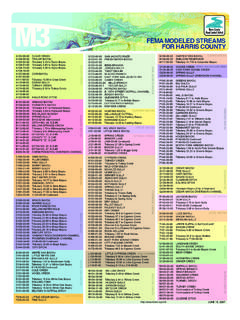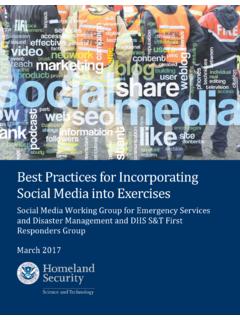Transcription of ASCE 41 - Seismic Rehabilitation
1 ASCE 41 Seismic Rehabilitation of Existing to define a Rehabilitation Objective How to define a Rehabilitation Objective per ASCE ASCE Collection and Collection and and and Topics:What is ASCE 41? It is mainly a combination of two fema It is mainly a combination of two fema documents:documents: fema 356 fema 356 Technical Requirements Technical Requirements for Seismic Rehabilitation of Buildings for Seismic Rehabilitation of Buildings Superseded by ASCE by ASCE 41. fema 274 fema 274 NEHRP Commentary on NEHRP Commentary on the Guidelines for Seismic the Guidelines for Seismic Rehabilitation of of Buildings.
2 ASCE 31 ASCE 31 Seismic Evaluation of Seismic Evaluation of Existing Buildings (supporting Existing Buildings (supporting document).document).Why use ASCE 41? To improve the Seismic performance of To improve the Seismic performance of any any existingexistingstructure:structure: ASCE 41 addresses Rehabilitation of ASCE 41 addresses Rehabilitation of Architectural, Mechanical, Electrical Architectural, Mechanical, Electrical and Structural Structural systems. ASCE 41 can be used to rehabilitate ASCE 41 can be used to rehabilitate historic structures.
3 Where performance based Where performance based rehabilitations are are is required for the Rehabilitation ? Seismic Evaluation must be performed A Seismic Evaluation must be performed to identify deficiencies to be rehabilitated. to identify deficiencies to be rehabilitated. ASCE 31 (Formerly fema 310) can be ASCE 31 (Formerly fema 310) can be used for the for the the Rehabilitation Objective Define the Rehabilitation Objective --a a combination of a Target Building combination of a Target Building Performance Level, an Earthquake Hazard Performance Level, an Earthquake Hazard Level, and an Objective , and an Objective Building Performance Level: ASCE 41 Structural Performance Level.
4 ASCE 41 and Tables and Tables C1--2,3, & 4 define six 2,3, & 4 define six levels:levels: Immediate Occupancy (Immediate Occupancy (SS--1)1) Damage Control Range (SDamage Control Range (S--2)2) Life Safety (SLife Safety (S--3)3) Limited Safety Range (SLimited Safety Range (S--4)4) Collapse Prevention (SCollapse Prevention (S--5)5) Not Considered (SNot Considered (S--6)6)Tables C1 Tables C1--2 to C12 to C1--4 defines typical 4 defines typical damage that accompany these that accompany these Building Performance.
5 Primary componentPrimary component Any structural element that resists loads and Any structural element that resists loads and deformations from Seismic loads in addition to gravity loads. deformations from Seismic loads in addition to gravity loads. Secondary Secondary componentcomponent any element that resists deformations + gravity element that resists deformations + gravity increasesDamage increasesTarget Building Performance Level: ASCE Nonstructural Performance Level: ASCE 41 and Tables C141 and Tables C1--5 & 6 define five 5 & 6 define five levels:levels.
6 Operational (Operational (NN--A)A) Immediate Occupancy (NImmediate Occupancy (N--B)B) Life Safety (NLife Safety (N--C)C) Hazards Reduced (NHazards Reduced (N--D)D) Not Considered (NNot Considered (N--E)E)Tables C1 Tables C1--5 & 6 define typical damage 5 & 6 define typical damage that accompany these accompany these Building Performance:Damage increasesDamage increasesTarget Building Performance:Example: NExample: N--A + SA + S--1 yields 11 yields 1--A Target A Target Building Performance Performance Hazard Level: BSE BSE 2 Event: An earthquake with a 2% 2 Event: An earthquake with a 2% probability in 50 years of being exceeded.
7 Probability in 50 years of being exceeded. This is an earthquake with a 2500 year This is an earthquake with a 2500 year reoccurrence period or the MCE as reoccurrence period or the MCE as defined in ASCE 7 or IBC. defined in ASCE 7 or IBC. BSE BSE 1 Event: An earthquake with a 10% 1 Event: An earthquake with a 10% probability in 50 years of being exceeded. probability in 50 years of being exceeded. This is an earthquake with a 500 year This is an earthquake with a 500 year reoccurrence period or the design event reoccurrence period or the design event defined in ASCE 7 or in ASCE 7 or BSE Basic Service EarthquakeBasic Service EarthquakeQUIZ ?
8 ??:What document did ASCE 41 replace?What document did ASCE 41 replace? The History of Future History of Future Architecture. Texas Architect. fema Objective Safety Objective Basic Safety Objective typical for Ancillary structures typical for Ancillary structures (Office buildings)(Office buildings) Rehabilitation Enhanced Rehabilitation Objective Objective typical for Critical typical for Critical or Essential structures or Essential structures (Hospitals, Fire stations, Police (Hospitals, Fire stations, Police stations)stations)
9 Rehabilitation Limited Rehabilitation Objective Objective (Other less critical (Other less critical structures)structures)You and your client define the req d and your client define the req d Objective:Now that you have defined you Rehabilitation Objective what is next?: Data CollectionData Collection Analysis RequirementsAnalysis Requirements ModelingModeling Results EvaluationResults Evaluation Design and Rehabilitation Design and Rehabilitation Data existing plans From existing plans a comprehensive testing programFrom a comprehensive testing programRequirements depend on your Rehabilitation Requirements depend on your Rehabilitation Objective and the information available Objective and the information available to you from existing you from
10 Existing is needed to obtain enough information Testing is needed to obtain enough information to build the linear or nonlinear model. to build the linear or nonlinear model. Material testing to support modeling can be Material testing to support modeling can be very expensive and time consuming. very expensive and time consuming. Knowledge Factor Knowledge Factor scale factor to reduce element scale factor to reduce element capacity due to uncertainty in element composition. capacity due to uncertainty in element composition.




